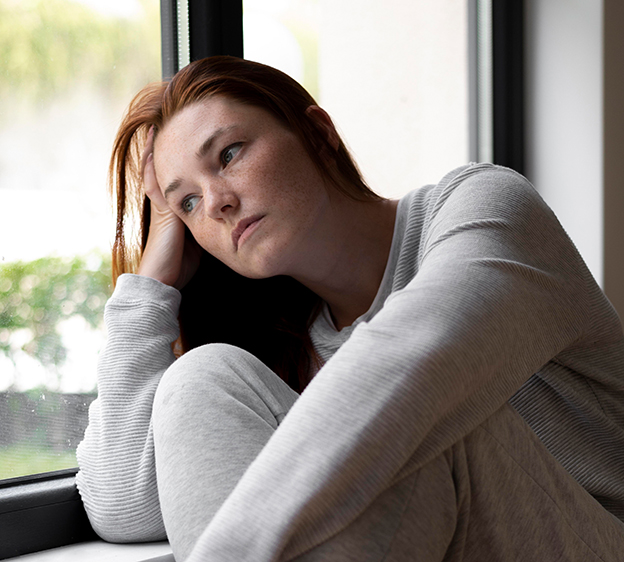Premenstrual Dysphoric Disorder vs. PMS: What’s the Difference?
January 14, 2025
Premenstrual syndrome, commonly known as PMS, is a common occurrence, affecting more than 90% of women who get a regular period.
But if PMS symptoms, such as bloating, cramping and mood swings, become so extreme they significantly affect your daily life, it could be a more serious condition called premenstrual dysphoric disorder (PMDD).
“Many people experience mood changes, irritability or physical symptoms like cramps just before getting their monthly period,” said Peyton McManus, PA-C, certified physician assistant with Beaufort Memorial Obstetrics & Gynecology Specialists. “But it’s important to understand that severe depression or anxiety is not a normal part of PMS, and you don’t have to live with it. If you think you might have PMDD, talk to your women’s health care provider right away.”
Read More: Could an Endometriosis Diet Help You Manage Pain?
Why Do Some Women Develop PMDD?
Researchers don’t know for sure what causes PMS or why some people have PMDD, but hormones likely play a big part.
During the menstrual cycle, levels of certain hormones in the body fluctuate, and this may affect some women more than others.
Women who develop PMDD may be more sensitive to a brain chemical called serotonin, which helps regulate many important functions such as mood, behavior and memory. Serotonin levels change throughout the menstrual cycle, and this could trigger PMDD symptoms in some people.
Other risk factors could also be involved in PMDD. Women who have mood disorders such as seasonal affective disorder (SAD) or severe depression might be at higher risk. Other possible risk factors for PMDD include:
- Being overweight
- A family history of PMDD
- Lack of physical activity
- Other conditions such as thyroid disorders or anxiety
Key Differences Between PMS and PMDD
Symptoms of PMS and PMDD can be similar, making it difficult to know whether what you are experiencing is a normal part of PMS. Both conditions can cause physical and emotional symptoms.
In general, PMDD is more severe and has a more significant effect on your quality of life.
Physical symptoms of both PMS and PMDD can include:
- Abdominal cramps
- Breast tenderness
- Constipation or diarrhea
- Fatigue
- Fluid retention and bloating
- Food cravings
- Headaches or backaches
- Sleep problems (getting too much or not enough sleep)
Emotional symptoms can also take a significant toll, including:
- Anxiety
- Bouts of crying
- Concentration or memory problems
- Depression or feelings of sadness
- Irritability
- Loss of interest in sex
- Mood swings
- Weight gain
But how can you tell whether what you are feeling is simply PMS or something more serious? PMDD affects your mental health more significantly and is usually more debilitating than PMS. Additional signs include:
- Episodes of binge eating
- Extreme anger or irritability
- Feeling like you are out of control
- Hopelessness
- Panic attacks
- Thoughts of suicide
Paying attention to when your symptoms begin and end can also help determine whether you have PMDD. PMS symptoms usually begin about five to 11 days before your period starts and stop around the time it begins.
With PMDD, symptoms begin one to two weeks before menstrual bleeding and improve a few days after your period starts.
Read More: Tired of Period Bloat? Here’s How to Manage It
How Is PMDD Diagnosed?
If you think you might have PMDD, make an appointment with your health care provider. There is no single test that can show whether you have PMDD, but there are things your provider can do to rule out other conditions and make a diagnosis.
It’s a good idea to record your symptoms in a journal, describing how they affect you and when they occur. Bring this journal to your appointment to give your provider a detailed picture of your symptoms.
Your provider will also:
- Go over your health history
- Perform a pelvic exam
- Order blood tests to check your thyroid hormone levels
Depending on your symptoms, your provider might also refer you for a psychiatric evaluation to ensure your mental health symptoms are not due to another condition.
You may be diagnosed with PMDD if you have at least five signs of PMDD, including at least one mood-related symptom, and your providers find no other cause.
How to Start Feeling Better
The good news is that treatment options are available to manage PMDD and help you feel better.
One option is medication. This might include:
- Anti-depressants. Selective serotonin reuptake inhibitors (SSRIs), which work by altering the levels of serotonin in your brain, can help improve depression caused by PMDD.
- Birth control pills. Some women with PMDD find improvement by taking a certain type of birth control pill that combines drospirenone (a synthetic version of progesterone) and ethinyl estradiol.
- Pain relievers. Taking over-the-counter medications like aspirin, ibuprofen or naproxen can lessen headaches, cramps and other physical PMDD symptoms.
Another big part of managing PMDD is making lifestyle changes. Your provider might suggest:
- Changing your diet. Make sure you are eating plenty of fruits, veggies and whole grains while limiting salt, sugar, caffeine and alcohol.
- Getting more exercise. Regular physical activity can help reduce the severity of some symptoms. Try to get 150 minutes of moderate aerobic exercise every week.
- Improving your sleep habits. Getting seven to nine hours of sleep every night is important for your overall health and can help lessen PMDD symptoms.
- Reducing stress. Practicing relaxation techniques such as deep breathing and meditation can make a positive difference.
Your provider might also suggest seeing a therapist to help you learn tools to better manage anxiety and stress.
Experiencing symptoms that affect your quality of life? Make an appointment with a women’s health provider at Beaufort Memorial.

